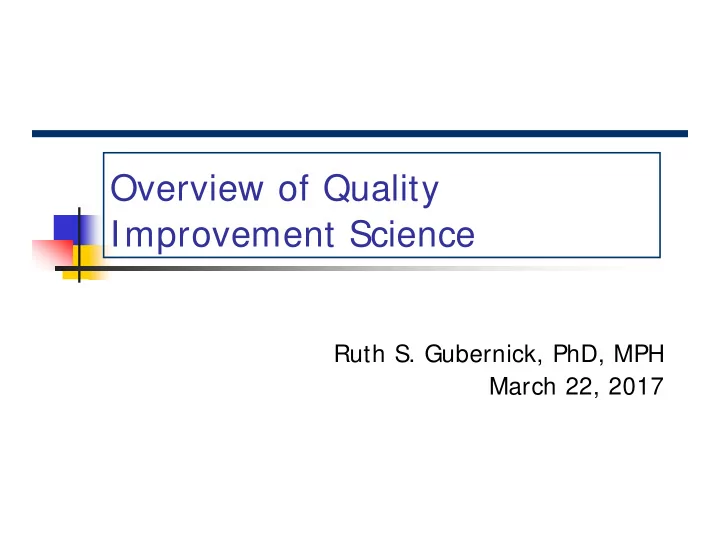

Overview of Quality Improvement Science Ruth S. Gubernick, PhD, MPH March 22, 2017
Objectives of this Session Develop a strategy for improving delivery of adolescent immunizations in a primary care setting Apply the Model for Improvement to test changes, using the EQIPP Toolkit and/or other examples of adolescent immunization-focused tools and resources
Research vs. Quality Improvement Measurem ent for Measurem ent for Learning and Research Process I m provem ent Purpose To discover new knowledge To bring new knowledge into daily practice Tests One large "blind" test Many sequential, observable tests Biases Control for as many biases Stabilize the biases from test to test as possible Data Gather as much data as Gather "just enough" data to learn possible, "just in case" and complete another cycle Duration Can take long periods of "Small tests of significant changes" time to obtain results accelerates the rate of improvement
It Takes an Effective Team to Do This Work! Members representing different kinds of expertise in the practice Clinical Leader Technical Expertise Day-to-Day Leadership Administrative Staff Patient/Parent/Caregiver Partners Project Sponsor
Model for Improvement What are we trying to AI M accomplish? How will we know that a MEASURES change is an improvement? What change can we make that I DEAS will result in improvement? Act Plan Study Do
AI M Worksheet The (name of your team ) intend to accomplish By (date) For (population) because Our goals include: Special guidance that will help us stay on track:
How will we know a change is an improvement? Requires measurement Build measurement into daily work routine Data should be easy to obtain and timely Small samples over time Use qualitative & quantitative data Quantitative data is highly informative Qualitative data is easy to obtain
Record Review: Up-to-date (Percent) 100 90 80 70 60 DDJZFE DOCRN3 50 happy6 40 HGH 30 20 10 0 Base Aug Sep Oct Nov Dec Jan Feb 8
All needed vaccines were given at the last visit (percent) 100 90 80 70 60 DDJZFE DOCRN3 50 happy6 40 HGH 30 20 10 0 Base Aug Sep Oct Nov Dec Jan Feb 9
The PDSA Cycle for Learning and I mprovement “What will happen if we try something Act Plan different?” • Objective • What changes “What’s next?” • Questions and are to be made? predictions (why) • Plan to carry out the cycle • Next cycle? (who, what, where, when) • Plan for data collection Study Do • Complete the • Carry out the plan analysis of the • Document problems data and unexpected • Compare data to observations “Let’s try it!” “Did it work?” predictions • Begin analysis • Summarize of the data what was learned
A PDSA Cycle P: Ask one doctor (Dr. M) to immunize at Act Plan a sick visit for A:Will try one • Objective 1 patient who • What changes • Questions and week is overdue for are to be made? predictions (why) shots Next cycle? • Plan to carry out the cycle (who, what, where, when) Study Do S: Was some • Complete the • Carry out the plan resistance, D: Dr. M • Document problems analysis of the data as predicted, immunized 2 • Compare data to and unexpected from mother. observations patients, 1 with predictions • Begin analysis fever. Caught • Summarize what of the data was learned patients up.
Use of the PDSA Cycles Changes that Multiple cycles Result in I mprovement A P S D Implementation of Change Wide-Scale Tests of Change Evidence A P Best Follow-up Tests S D Practice Testable Very Small Scale Test I deas
Task or Test? Task Test To do’s Question Meetings Prediction Posters Data Policy Usually involves patient Committees
Decrease the Time Frame for a PDSA Test Cycle Years Quarters Drop down next Months “two levels” to Weeks plan Test Cycle! Days Hours Minutes
What is Important to Understand About Testing? Change isn’t permanent No support for change beyond test period Learning from testing will be significant—up to 50% of tests not expected to yield improvement Fewer # of people affected by the test (lower risk) It will provide you with the data to prove that a new way works better Source: Langley et al. 1996. The Improvement Guide: A Practical Approach to Enhancing Organizational Performance. p114.
Tips for Testing Changes Stay a cycle ahead Scale down scope of tests – START SMALL Pick willing volunteers (work with those that want to work with you) Avoid the need for consensus, buy-in, or political solutions Replicate changes made elsewhere Pick easy/feasible changes to try Avoid technical slowdowns Reflect on the results of every test (successful AND failed tests)
MODEL FOR IMPROVEMENT CYCLE :____ DATE :____ Objective for this PDSA Cycle A P S D PLAN : QUESTIONS : PREDICTIONS : Form for PLAN FOR CHANGE OR TEST: WHO, WHAT, WHEN, WHERE planning a PDSA cycle PLAN FOR COLLECTION OF DATA: WHO, WHAT, WHEN, WHERE supports prediction DO : CARRY OUT THE CHANGE OR TEST; COLLECT DATA AND BEGIN ANALYSIS. and keeping STUDY : COMPLETE ANALYSIS OF DATA; SUMMARIZE WHAT WAS LEARNED. one step ahead ACT: ARE WE READY TO MAKE A CHANGE? PLAN FOR THE NEXT CYCLE.
Over all Aim: Impr oving Adolesc ent Immunization Cover age R ates (and Pr eventing Disease!) Assess Elicit Administer Conduct immunization patient/family all eligible R eminder s/ status at every concerns vaccines R ec alls visit
How teams get results Engage leaders Form team Assign responsibility for key tasks Meet Small tests of change Use of the IIS Use of best practices, tools and resources
Questions/Comments?
Recommend
More recommend